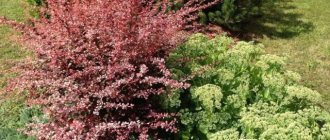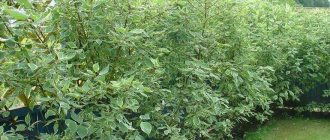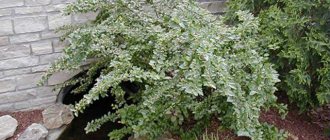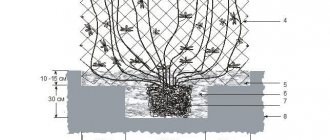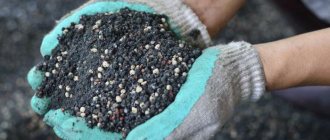Characteristics
Parthenocissus (Parthenocissus), popularly called wild, girlish grapes. The plant is a liana-like plant, the lashes of which reach 25 meters. It has inconspicuous flowers and inedible berries.
There are 12 species of Parthenocissus. In central Russia, virginia (five-leafed) and ivy (tripointed) are grown. They easily reproduce by layering, root shoots, cuttings, and are not afraid of harsh winters.
The liana grows on any soil and develops well in shade and partial shade. In sunny places, growth slows down, the leaves decrease in size, and in hot, dry summers the greenery becomes reddish-red.
Appearance:
The plant is independently supported on vertical supports with the help of tendrils. The leaves are dark green, shiny, 25x30 cm in size. Flowering in the form of inconspicuous inflorescences. The fruits are dark blue, small, round, collected in a loose cluster. In autumn, with the onset of cold nights, the foliage takes on purplish-red hues.
The branch holds firmly to any support with its tendrils. Photo: is.co.at
Planting virgin grapes has an attractive appearance and helps to zone the area. Let's talk about the pros and cons of this culture.
Advantages:
- Undemanding to soil composition.
- Shade tolerance.
- Rapid growth (3 meters over the summer).
- Resistance to diseases and pests.
- Grows without watering, loosening, weeding or fertilizing.
- Creates a dense screen from wind, dust, and light precipitation.
- Easily propagated.
- Does not freeze without shelter down to -40 °C.
- Gives a picturesque look to the area.
Flaws:
- Needs support.
- In a limited area, plantings need to contain growth - regular haircuts are required (3-4 times per season).
- Without constant control and pruning, it quickly suppresses neighboring plants, including trees.
- Late bud break. Until the beginning of June, the branches remain bare, the plantings have an unsightly appearance.
- When grown on the facade of a building, it can destroy wooden elements and penetrate under the roof.
How to make a hedge from virgin grapes
Comparing green fences with their technological prototypes, they note the inherent advantages of the former:
- artistic appearance;
- plasticity of formation;
- eliminating the need for periodic construction and finishing works;
- cost-effectiveness, possibility of independent implementation;
- durability;
- dust collection, ionization, saturation of air with oxygen, for some species - antibactericidal effect from the release of phytoncides, improvement of the microclimate;
- wind protection of the site;
- good noise absorption due to dense foliage cover;
- inability to visually observe through foliage;
- attracting insects and birds to the garden
Land owners who decide to install a hedge will have to come to terms with the following:
- it takes at least two years to achieve significant results;
- planting, caring for plants during the growing season, pruning - require time, skills or the involvement of specialists;
- not all crops are self-supporting; vines require strong support;
- falling leaves, spoiling the appearance, reducing protective functions;
- waterlogging of the soil near planting;
- the possibility of withering from spontaneous outbreaks of diseases, mass attacks of pests, atmospheric emissions;
- different resistance to adverse weather conditions, climate, and anthropogenic factors.
Nine “for” in favor of girlish grapes
The hedge is an ancient invention, the villas along the Appian Way hid the life of the patricians behind the weaving of vines, a classic English estate is unthinkable without vines climbing along the stonework.
Many shrubs and trees are suitable for creating a living fence: willow, barberry, lilac, cotoneaster, hawthorn, forsythia, rose hips, quince. What is the preference for virgin grapes? Characteristic qualities include:
- Unpretentious to soil, lighting, air humidity, care.
- Availability : widespread, planting material is cheap.
- Easy propagation, good survival rate after planting.
- Resistance to adverse environmental conditions and diseases.
- Exceptional growth rate , shoots lengthen by 3 - 4 m per season, total length reaches 30 m.
- Compliance to the formation of horizontal and vertical crowns due to the ability to be fixed with tendrils on steep surfaces.
- Long growing season : from April to October, the leaves remain, changing color until frost.
- Longevity : 50 – 100 years.
- Decorative : leaf blades are expressive, the depth of color saturation varies depending on the light. Emerald green is replaced by gold and the crimson of autumn foliage, the play of light creates unique canvases with a rich palette of shades.
How to plant wild grapes in 3 steps
Choose open areas for the vineyard. There should be no trees or bushes at a distance of 1.5 meters. When actively growing, the vine forms a dense wall and creates thick shade. There should be no beds or flower beds nearby that need sun.
- Reproduction
A hedge requires many seedlings. Usually they are borrowed from neighbors or grown in advance. There are different methods of propagation; the table shows rooting and planting options:
| Offspring Maiden grapes form shoots next to the bush. These are independent plants with a developed root system. These are ready-made seedlings that can easily adapt to a new location. They are dug up with the roots of the soil and planted in increments of 70 cm. | |
| Layerings The lash of Parthenocissus, upon contact with the ground, becomes overgrown with roots. Therefore, the grape stem is ideal for vegetative propagation. Last year's shoot is taken for rooting. It is buried 3–5 cm or simply pressed/pinned to the ground. The branch is not cut from the mother plant. The rooting process will be faster if the soil is kept moist. After 15–20 days, roots appear. After a month, the rooted shoot can be cut off from the bush, divided into parts and transplanted to a new place | |
| Rooting in water A strong branch from last year is selected and cut into cuttings. The length of the stems is arbitrary; it is important that the cuttings have at least two leaves. Place the cuttings in a container with water; it should cover only the bottom of the shoot (5 cm). Root formation begins quickly and actively. You can grow it in cups with soil or immediately place it in a permanent place | |
| Cuttings A segment of a branch with several growth points forms 2–3 shoots at once. Cuttings make it possible to grow bushy seedlings. To cut cuttings, you need to take last year's shoot with young growth. The selected segment should have buds with 2-3 lateral branches coming out of them. When cut, at the lower end of the cutting there should be a woody part 5–10 cm long with 1–2 tubercles or tendrils. The total length of the cutting is about 20–30 cm | |
| Rooting in the ground When a lot of seedlings are needed, the chopped stems are planted in a permanent place or grown in a plot in cups. The bottom of the cutting is deepened by 5–7 cm, long branches by 15–20. The soil should be constantly moist - this will speed up root formation. After 7–10 days, roots will appear, a month later the first leaf will appear. Active growth will begin next season |
The fastest growing varieties of virgin grapes should be planted along the fence. It is recommended to purchase Virginsky, Thomson, Parthenocissus Volosisty, Amursky Proryv, Star Showers, Henry, Wiche.
- Material selection
The best option for a grape fence is metal (mesh, rod, profile, etc.). For a wooden or concrete structure, a reinforced mesh shield is installed nearby. This will protect the fence from destruction. The time to establish a plantation depends on the planting material.
- Soil preparation
Any soil is suitable for wild grapes. If desired, compost or soil from the beds is added to the planting holes; heavy soil is diluted with sand. In loose, fertile soil, the root system will develop well, and the bushes will give powerful growth.
The depth of the holes depends on the size of the roots, usually 15–30 cm. The interval between seedlings is 60–80 cm. To quickly obtain a dense green wall, the distance when planting is reduced to 50 cm.
In depleted soils, superphosphate and potassium are added for digging, a handful per 1 m²
Varieties of shrubs for creating a living fence
When creating a living fence, the following types of hedges are distinguished:
- three-pointed girlish. This species was bred in the 19th century. The liana reaches a length of 20 meters, is unpretentious to the planting site and soil, and branches well. The variety is not resistant to low temperatures; if the temperature drops from -15 degrees, it may die. The shrub is suitable for planting near country houses. Rising upward, the branches of the plant cover the building and form a dense green wall. By autumn, the plants produce clusters of blue-black berries;
- Henry grape variety. The shrub has variegated leaves; by autumn they become a beautiful crimson color;
- five-leaf maiden grape. The variety prefers moist soil, the vine grows up to 20 meters. The leaves of the grape are variegated, the bush can bloom from 3-4 years of age. Such a hedge can be organized on poor soil, in the shade. The plant is resistant to temperature changes.
·
Rules of care
Young plantings need weed removal and regular watering. Try to keep the soil moist to promote root and above-ground growth. 4–5 liters are poured onto each bush, 2–3 times a week.
Mature plantings do not need watering. To maintain a decorative appearance, the following techniques are used:
- In the spring, the grapes are inspected. Dried branches and those extending beyond the contour of the fence are removed.
- To enhance growth, 2 tbsp of urea is added in May. l. per sq./meter In the summer, nitroammophoska is given in the same proportions.
- During the period of active growth, a shaping haircut is carried out.
Rules for growing wild grapes can be seen in the video
Beneficial properties of fruits
In folk medicine, the fruits are used to prepare remedies for many ailments:
- diseases of the gastrointestinal tract;
- diarrhea, diarrhea;
- increased stomach acidity;
- increase in hemoglobin.
Read more: Burdak: characteristics of its grape varieties
Also, medicines from the fruits of wild grapes help improve blood and metabolism.
The berries of the plant should not be eaten, especially in large quantities: virgin grapes are poisonous and can lead to severe intoxication of the body.
Options for securing branches
Wild grapes must have support. Young plantings without guides will hang down and crawl along the ground. Let's consider options for attaching shoots.
Trellis design. Photo: eda-land.ru
Method 1. Ready fence
The structure of chain-link mesh and iron rod are ideal for supporting the lashes. The liana is independently fixed with tendrils and rises through the cells. A concrete or brick plane without additional devices is unsuitable for vine growth.
The lashes are independently fixed to the rod fence. Photo: xn--80adiweqejcms5i.xn--1-8sbfmxioer8j9a.xn--p1ai
Next to such fences, a mesh/trellis structure is installed or wire is stretched. These devices help secure the vine to the wall.
Method 2. Green hedge without a fence
Living fencing can be done without using a fence. A frame is created to hold the grapes in an upright position. This is not a fence, but guides for creating a green wall: pillars and cross beams.
Any material can be chosen. The tree will last no more than 10 years, so it is advisable to use an iron rod, corners, pipes, and profiles. The metal will last for several decades. The stability of the structure depends on the installation of vertical supports. The pillars should be buried 60–80 cm into the ground.
Rail guides. Photo: klumba.guru
Method 3. Racks for vines
Arches, pergolas and other structures intended for the vineyard must be of durable construction. At the age of seven, the vine has thick, woody branches. Under the weight of its own mass and young growth, it will gradually sag. Stands with 2–4 transverse strips made before planting help eliminate this situation.
The vines on the fence are secured with a metal/plastic mesh or supported by wire. Photo: i.ytimg.com
How to propagate an ornamental shrub
A hedge of maiden grapes propagates in several main ways:
- layering;
- cuttings;
- seeds.
Cutting propagation. This option for making a living fence is considered the most affordable. The material used is cuttings, their length is 20-25 cm, thickness 1-2 cm. Cuttings can be used in spring and autumn, several live buds are left on them. The cuttings are placed in a hole 10-15 cm deep, there should be 2-3 buds on the surface of the ground, sprinkled with earth.
Advice! There is no need to use mineral fertilizers when planting; the seedlings take root well.
Reproduction by layering. This method allows you to increase the number of plants in the shortest possible time, making the hedge lush and beautiful. A vine vine with buds is buried in soil and watered. Gradually the shoots will take root and you can plant them.
Propagation of shrubs by seeds. The most time-consuming and labor-intensive is propagating grapes from seeds.
Features of planting seeds:
- Such planting should be carried out in spring or autumn.
- It is necessary to heat the seeds before planting. They are soaked for 2-3 hours in cold water, wrapped in cloth, and placed in the refrigerator for 3-4 days.
- Planting of seeds is carried out in loose soil; the seeds are placed at a depth of 1-2 cm.
DIY grape gazebo
The walls of the gazebo, entwined with vines, protect from the sun and wind and create a cozy interior space. You can make any design with your own hands; I will list the possible options for gazebos:
- attached to the wall of the house;
- in the form of an arch;
- tent;
- multifaceted;
- domed/rounded;
- trellis with canopy.
The basis of any structure are vertical pillars holding trellises or guides. The best material for poles is iron; wood quickly becomes unusable when exposed to moisture.
4 years after planting. Photo: stroy-podskazka.ru
I will give step-by-step instructions for building a grape arbor, which is made from any material.
- Marking the territory.
- Determining the location for the pillars (span no more than 1.5 m).
- Digging holes (60–80 cm), installing vertical posts (checking plumb and level), filling with cement.
- Mounting the roof frame, installing the covering.
- Creating a bundle of rods/battens.
- Attaching the sheathing for grapes. A decorative wall under a vine is made of slats connected by a square or a rhombus.
The height of the grape arbor should not exceed two meters. On tall structures it will be difficult to care for the plant.
Reiki sold by diamond
Role in the garden
Decorating your home with wild grapes
Every plant in the garden plays its own individual role. Maiden grapes can be used in various styles and roles.
As a hedge. To create an impenetrable wall that will cover the entire garden or a corner of it from prying eyes, you just need to pull the net and plant a few bushes of the described grapes. As a support, you can simply use metal wire stretched in several rows. This type of hedge does not require constant pruning.
As a border. As a border plant, wild grapes are suitable for large-scale compositions. This could be a large pond or a composition of large conifers. In this case, mandatory pruning is necessary to maintain shape.
As raw material for creating architectural forms. Girlish grapes are able to braid any obstacle - from a wall to airy and openwork structures.
If this is an ordinary arch, then it is enough to plant a grape bush near each of its supports. The basis for creating a composition can be the shape of a ball, cube, or animals. With the help of wild grapes you can create absolutely fantastic projects. For example, growing a large ship in the garden.
In order to close the ground. The unexpected use of wild grapes as a ground cover has its advantages. This plant requires minimal care. Pruning in this case will not be a stumbling block, because it is not necessary here.
To protect buildings from the scorching rays of the sun. The excellent property of this universal vine to twine around almost anything that can be caught on, serves to decorate and protect various buildings - from a gazebo to the wall of a house. The only limitation is the strength of the building.
It is also not recommended to give wooden buildings without sufficient ventilation or decorative finishing of houses to the power of vine vines. Under the weight of greenery, these elements can become unusable. Maiden grapes cling with suction cups and will be difficult to separate from the wall without damaging the plaster or other coatings.
Protection from dust and noise. A fairly dense wall, which is formed by overgrown vines, serves as good protection from street noise and dust.
Decorating a brick fence with wild grapes
To strengthen a slope or slope. Deprived of support, such grapes take root and spread across the ground where grass or other ground cover plants cannot grow.
As an ampelous plant. It is interesting to use wild grapes in hanging pots.
By trimming it can be shaped into a ball. Without pruning, the plant grows freely and can be used as a decoration for old dried out trees or lamp posts.
The universal property of virgin grapes to adapt to any role is indispensable when designing a garden.
Expert opinion
Yulia Yurievna
I have a large garden and vegetable garden, several greenhouses. I love modern methods of cultivating plants and mulching the soil, and I share my experience.
Ask a Question
If you decide to plant such a plant to create a hedge or to decorate a fence, you need to remember that the grapes will grow greatly over time and its branches will be quite heavy. For this reason, supports must be immediately selected that are powerful enough.
If you use a regular wire mesh, there is a chance that over time it will begin to sag under the weight of the vines. In this case, it is worth either thinning the bush, or making the spans of the stretched trellis small, and attaching it to special support posts to distribute the load.
Often this plant is allowed to trail onto the gazebo. This allows you to create a cozy shady corner. This is especially convenient, since care for such grapes is kept to a minimum. Especially when you compare it with other plants that are used for such purposes, for example, climbing roses.
Due to the density and density of the shoots, it is possible to organize a kind of summer gazebo from such a vineyard. You just need to tighten the supports to the required shape. The fast-growing vines will do the rest themselves.
Remember
- Trim the girl's grapes. Unpretentiousness, rapid growth and tendency to spread can create problems. Without pruning, wild grapes quickly conquer the territory and oppress neighboring plants.
- Select material for supports . Wooden structures quickly rot under dense greenery. It is better to use a metal rod to support the branches, and wire for guides.
Maiden grapes decorate any design. A vine fence does not require large expenditures and protects the area from dust and prying eyes.
A little history and description of the plant
Such a simple and very familiar girlish grape is called wild. It has varieties that are not yet known to all gardeners:
- Virginia five-leaved.
- Tripointed Vicha grapes.
Gazebo made of wild grapes
Five-leaf grapes, the most common type of wild grape, were born in Asia a long time ago. Over many centuries, it has spread throughout the world and adapted to various living conditions.
The leaves of this species grow from one internode in the amount of five pieces at once, placing their blades in different directions. All summer the leaves delight with their greenery, and in the fall they are covered with crimson.
The vines of such grapes reach a length of about twenty meters. In one season, a shoot from a new cutting can grow up to 4 meters long.
Features of this type:
- Frost resistance.
- Undemanding to humidity.
- Undemanding to soil fertility.
- Fast growth.
- There are many simple and reliable methods of reproduction.
Tri-pointed or Vicha grapes got their name due to the peculiarity of the leaf structure and began to spread from Japan and China.
Unlike the previous species, the leaves of the Vicha grape look like an animal's paw with three fingers and membranes. On a triple-cut leaf of a small size, the veins are very clearly visible.
Growing, Vicha grapes will paint a picture of even, neat, similar small leathery leaves over a couple of seasons. Rich green in color, with lighter, more pronounced veins, they are located one above the other and present a complete picture of a tiled roof. The only external difference from it is the green color.
The autumn colors of this type of grape are more varied. Each leaf turns two or even three colors when cool temperatures set in. Very interesting transitions from one color to another, combined with an unusual leaf shape, give this species the first place among decorators of large vertical or horizontal areas.
Differences between Vicha grapes and others:
- Appearance.
- Not very high frost resistance.
- Leaf size.
- Superficial occurrence of roots.
- Difficulty of reproduction.
Nevertheless, all types of this grape have similar features:
- Fast growth.
- Beautiful leaves.
- Ability to grow over large areas.
The five-leaf type of grape is more common due to its survival rate. But in terms of decorativeness it is inferior to Vinca grapes. The gardener should choose between two decorators or grow them together in different parts of the garden.
Site preparation
Growing virgin grapes is not difficult if you choose the right place and prepare it for planting. This variety is absolutely not picky about the soil in which it will grow, so the gardener should pay attention to a number of third-party nuances:
- Wild grapes have a strong, dominant root system. It can turn out tiles, destroy the foundations of buildings and choke out other plants. To prevent this from happening, it is best to plant the variety at a distance from the beds, preferably on a fence.
- When planting wild grapes on a hedge, you don’t have to worry about not getting enough light. But on the north side the leaves will be more faded than on the south (due to the climatic characteristics of the temperate region).
When preparing a site for planting, it is necessary to thoroughly loosen the soil. Young roots quickly begin to actively grow, so they need pliable soil for the first “jerk”. After they gain strength, the knocked down earth will not cause them any inconvenience.
Application
Wild grapes decorate all the inconspicuous and unattractive places in the garden.
The loach plant creates unusually beautiful thickets along the fence and gazebos. Terraces are decorated with wild plants. It is used to create beautiful hedges in the form of various shapes.
The liana is planted as a ground cover plant. The variety copes well with the function of a hedge. It is used for the preparation of medicinal products.
The shoots and leaves of the plant are given to rabbits. This is an excellent food for them, rich in vitamins and minerals.
What does a green hedge look like, do wild (maiden) grapes produce fruit? Wild grapes are difficult to confuse with selected varieties, and the names of individual species are often heard by winegrowers who want not only the harvest and berries, but also the beautiful appearance of their plantings. A simple vine with lush green leaves will cover an old wall or hedge, or any area in need of paint or restoration.
Even beginners (planting in spring or autumn) who have not previously cultivated their own vineyard can plant wild grapes. It is not recommended to plant selected varieties along the fence, especially on the street side; planting them will not lead to anything good. Such actions will lead to the most unpleasant results. The environment and negative factors can destroy all human work. It is not recommended to replant even wild grapes to another place.
The choice of planting site should be taken seriously and thoroughly, otherwise there is no point in starting preparations for planting a green fence. It is necessary to take cuttings in advance, as with any other domestic variety. It is possible to plant wild grapes in literally any soil, except for saline soils, which are unsuitable for planting vines. Wild varieties are propagated not only by cuttings (moistened seedlings, planted in the fall), but also by seeds.
Each type of material that is planned to be planted needs preparation. You should be especially careful with cuttings, because vine cuts are susceptible to various diseases, and improper maintenance of the cuttings leads to rotting of the material. How to plant grapes and create shade? Grapes, which are black in color and small in size, should not be eaten under any circumstances.
Flaws
Grapes need to be trimmed regularly
Disadvantages of wild grapes:
- the massive and rapidly growing root system of the vine can destroy the fence, especially if it is built from cement or corrugated sheeting;
- if you plant grapes along a fence with other plants, the neighbors have little chance of further growth and development (the root system of the maiden grapes will take away all the moisture and nutrients);
- Considering that the plant has a late growing season, the fence will remain bare until the beginning of summer; it will begin to be covered with emerald foliage only in July;
- During the growing process, the decorative vine needs regular pruning.
It is difficult to get rid of an intensively growing plant. To completely destroy and remove a wild vine, you will need to carry out a number of measures: completely remove the shoots, repeatedly water the roots and soil with herbicides.

